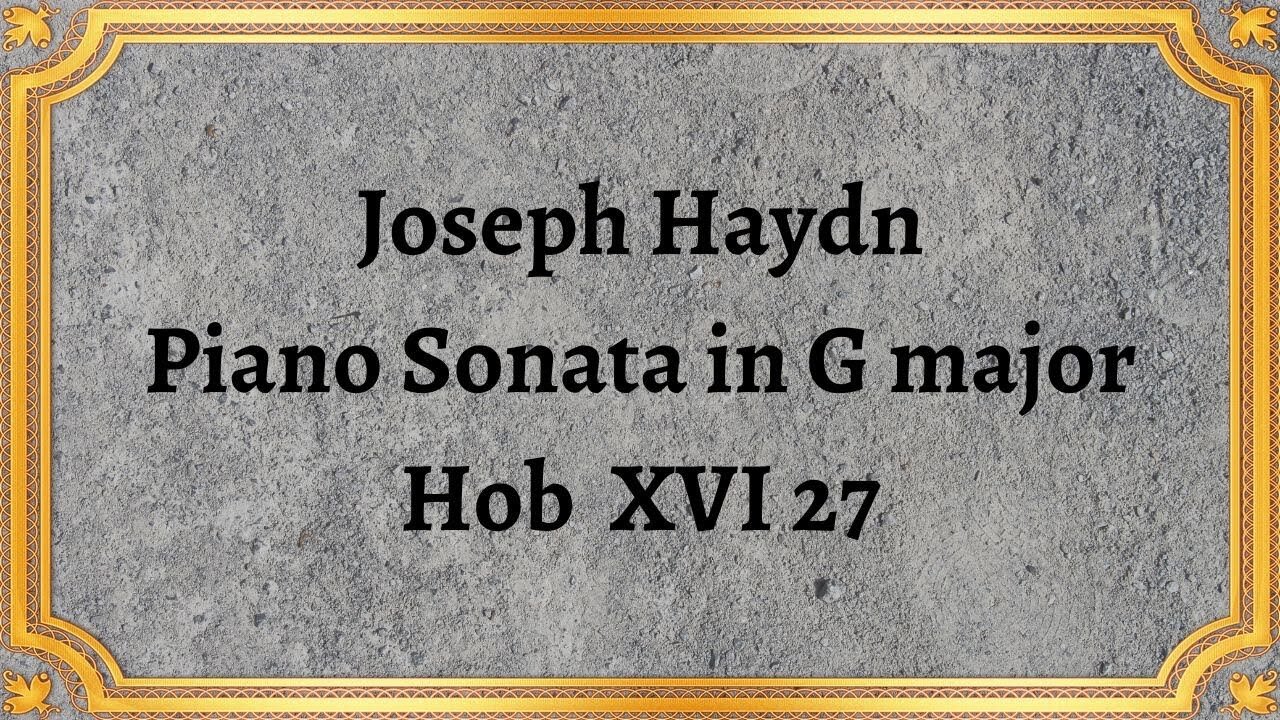Premium Only Content

Joseph Haydn Piano Sonata in G major, Hob XVI 27
#JosephHaydn #PianoSonata #Gmajor #HobXVI27 #musicalcomposition #sonataform #pianorepertoire #melody #harmony #chromaticism #musicappreciation #classicalmusic #musiceducation
Joseph Haydn's Piano Sonata in G Major, Hob. XVI:27, is a remarkable example of the composer's genius. It is one of the most beautiful and important works in the solo piano repertoire, and one that has been admired by musicians and music lovers alike for centuries.
The Sonata is composed in three movements and has a typical sonata form structure. The first movement is in fast tempo, showing Haydn's intense and assertive style. The second movement is slow and lyrical, displaying Haydn's exceptional ability to write beautiful melodies. Finally, the last movement is lively and upbeat, with rapid notes and complex rhythms.
The main theme of the Sonata is recognizable immediately, and it is used throughout the Sonata as a unifying element. Haydn follows a conventional sonata form, but he manages to evoke new and innovative ideas while still adhering to the form with a sense of logic and inherent structure.
The Sonata showcases Haydn's technical and innovative use of the keyboard while remaining accessible and enjoyable to the listener. The use of leaps, trills, running arpeggios, and unique chords showcase Haydn's unique musicality and creativity. Additionally, the Sonata demonstrates Haydn's mastery of harmony, rhythm, and melodic development.
Furthermore, the Sonata's harmonic language is ahead of its time. The music is expressive, and the chord progressions used are far from the simple and predictable progressions that were common in the Classical period. Haydn's use of chromaticism and modulations to unrelated keys was new and exciting, and it influenced many future composers.
In conclusion, Joseph Haydn's Piano Sonata in G Major, Hob. XVI:27, is a magnificent work of music, showcasing Haydn's artistic and technical skills as a composer. The Sonata illustrates how Haydn was able to push the boundaries of the typical sonata form while still remaining true to the conventions of the time. The Sonata has been admired by countless musicians and audiences over time and continues to be celebrated as a groundbreaking and significant work in the piano repertoire.
You have the opportunity to support the channel https://destream.net/live/RadSiarAl/donate
-
 1:35:12
1:35:12
Glenn Greenwald
9 hours agoCNN And Jake Tapper In Deep Trouble In Defamation Lawsuit: With Jonathan Turley; TikTok Ban, Trump's China Policy, And More With Arnaud Bertrand | SYSTEM UPDATE SHOW #390
85.3K47 -
 12:24
12:24
Dan Bongino Show Clips
10 hours agoPresident Trump Full Interview - 01/16/25
115K284 -
 1:27:39
1:27:39
Man in America
10 hours agoBig Pharma's Deadliest Lie is Being EXPOSED to the Masses w/ Jonathan Otto
36.4K17 -
 1:40:08
1:40:08
Precision Rifle Network
1 day agoS4E2 Guns & Grub - Training Vs. Competition
17.8K -
 58:27
58:27
Flyover Conservatives
1 day agoGarrett Ziegler Breaks Down Special Councilor’s Report on Hunter Biden. Insights for Trump’s Top Picks. | FOC Show
46.3K1 -
 44:54
44:54
Steve-O's Wild Ride! Podcast
13 hours ago $8.27 earnedMark Wahlberg Threatened To Beat Up Jackass Cast Member - Wild Ride #251
100K11 -
 1:13:34
1:13:34
Josh Pate's College Football Show
7 hours ago $1.02 earnedCFB Dynasties & Villains | Marcus Freeman OR Ryan Day | 2025 Sleeper Teams | Cole Cubelic Joins
28.7K -
 1:00:26
1:00:26
The StoneZONE with Roger Stone
5 hours agoSHOCKING NEW TAPE PROVES LBJ KILLED JFK! | The StoneZONE w/ Roger Stone
48.8K19 -
 1:44:33
1:44:33
ObaTheGreat
8 hours agoCrypto vs The World w/ Oba The Great And YaBoySkey
37.8K3 -
 LIVE
LIVE
VOPUSARADIO
2 days agoPOLITI-SHOCK! "COUNTDOWN TO TRUMP" & THE GLOBALISTS BURNING IT ALL DOWN..LITERALLY!
62 watching